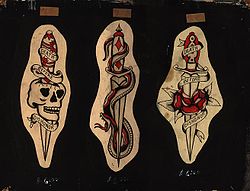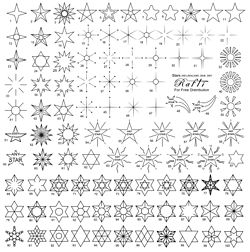Flash (tattoo)
This article needs additional citations for verification. (January 2019) |



A tattoo flash is a design printed or drawn on paper or cardboard, and may be regarded as a species of industrial design. It is typically displayed on the walls of tattoo parlors and in binders to give walk-in customers ideas for tattoos. Most traditional tattoo flash was designed for rapid tattooing and used in "street shops" - tattoo shops that handle a large volume of generic tattoos for walk-in customers.[1][2]
Flash is either drawn by the individual tattooist for display and use in their own studio, or traded and sold among other tattooists. Hand-drawn, local tattoo flash has been largely replaced by professional "flash artists" who produce prints of copyrighted flash to sell at conventions or through the Internet.
By the year 2000, most tattoo studios had become custom shops with the flash serving largely as a reference for ideas. Most tattoo designs are created by the tattoo artist developing an idea brought in by the customer.
There is no standard size for tattoo flash, but it is most commonly found on 11x14 inch prints in North America, and at A3 paper size in Europe. Tattoo flash may or may not come with an outline, also known as a line drawing. This outline is typically printed on a separate sheet. This is convenient for the tattoo artist, who would otherwise have to draw the linework for themselves.[3]
See also[]
- Body modification
- Scarification
- Tattoo machine
References[]
- ^ "Tattoo Designs". Retrieved 11 September 2018.
- ^ Vail, David J.; Sanders, Clinton (2008). Customizing the Body: The Art and Culture of Tattooing. Philadelphia: Temple University Press. ISBN 1-59213-888-8.
- ^ "Tattoo Designs". Retrieved 20 March 2016.
- Tattooing
- Drawing aids